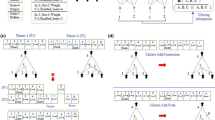Abstract
A model for co-evolving behavior control and morphological development is presented in this paper. The development of the morphology starts with a single cell that is able to divide or die, which is controlled by a gene regulatory network. The cells are connected by springs and form the morphology of the grown individuals. The movements of animats are resulted from the shrinking and relaxation of the springs connecting the lateral cells on the body morphology. The gene regulatory network, together with the frequency and phase shifts of the spring movements are evolved to maximize the distance that the animats can swim in a given time interval. To facilitate the evolution of swimming animats, a term that awards an elongated morphology is also included in the fitness function. We show that animats with different body-plans emerge in the evolutionary runs and that the evolved movement control strategy is coupled with the body plan.
Access this chapter
Tax calculation will be finalised at checkout
Purchases are for personal use only
Preview
Unable to display preview. Download preview PDF.
Similar content being viewed by others
References
Taylor, T., Massey, C.: Recent developments in the evolution of morphologies and controllers for physically simulated creatures. Artificial Life 7(1), 77–87 (2001)
Sims, K.: Evolving virtual creatures. In: Proceedings SIGGRAPH, pp. 15–22 (1994)
Hornby, G., Pollack, J.: Evolving L-systems to generate virtual creatures. Computers & Graphics 25, 1040–1048 (2001)
Miconi, T., Channon, A.: An improved system for artificial creatures evolution. In: Proceedings of Artificial Life X, pp. 255–261 (2006)
Spector, L., Klein, J., Feinstein, M.: Division blocks and the open-ended evolution of development, form, and behavior. In: Proceedings of GECCO, pp. 316–323 (2007)
Kitano, H.: A simple model of neurogenesis and cell differentiation based on evolutionary large-scale chaos. Artificial Life 2(1), 79–99 (1995)
Eggenberger, P.: Evolving morphologies of simulated 3d organisms based on differential gene expression. In: Proceedings of Artificial Life IV, pp. 205–213 (1997)
Bongard, J.C., Paul, C.: Investigating morphological symmetry and locomotive efficiency using virtual embodied evolution. In: Proc. of SAB, pp. 420–429 (2000)
Jones, B., Jin, Y., Sendhoff, B., Yao, X.: Evolving functional symmetry in a three dimensional model of an elongated organism. In: Artificial Life XI, pp. 305–312 (2008)
Mazzapioda, M., Cangelosi, A., Nolfi, D.: Co-evolving morphology and control: A distributed approach. In: Congress on Evolutionary Computation (2009) (in press)
Oros, N., Steuber, V., Davey, N., Canamero, L., Adams, R.: Evolution of bilateral symmetry in agents controlled by spiking neural networks. In: IEEE Symposium on Artificial Life, pp. 116–123. IEEE Press, Los Alamitos (2009)
Jones, B., Jin, Y., Yao, X., Sendhoff, B.: Evolution of neural organization in a hydra-like animat. In: Köppen, M., Kasabov, N., Coghill, G. (eds.) ICONIP 2008. LNCS, vol. 5506, pp. 216–223. Springer, Heidelberg (2009)
Steiner, T., Schramm, L., Jin, Y., Sendhoff, B.: Emergence of feedback in artificial gene regulatory networks. In: Proc. of CEC, pp. 867–874 (2007)
Jin, Y., Schramm, L., Sendhoff, B.: A gene regulatory model for the development of primitive nervous systems. In: Köppen, M., Kasabov, N., Coghill, G. (eds.) ICONIP 2008. LNCS, vol. 5506, pp. 48–55. Springer, Heidelberg (2009)
Klein, J.: BREVE simulation environment. Open-Source Software Package, Source Code Available at, http://www.spiderland.org/
Sfakiotakis, M., Tsakiris, D.: Simuun: A simulation environment for undulatory locomotion. International Journal of Modelling and Simulation 26(4), 350–358 (2006)
Author information
Authors and Affiliations
Editor information
Editors and Affiliations
Rights and permissions
Copyright information
© 2011 Springer-Verlag Berlin Heidelberg
About this paper
Cite this paper
Schramm, L., Jin, Y., Sendhoff, B. (2011). Emerged Coupling of Motor Control and Morphological Development in Evolution of Multi-cellular Animats. In: Kampis, G., Karsai, I., Szathmáry, E. (eds) Advances in Artificial Life. Darwin Meets von Neumann. ECAL 2009. Lecture Notes in Computer Science(), vol 5777. Springer, Berlin, Heidelberg. https://doi.org/10.1007/978-3-642-21283-3_4
Download citation
DOI: https://doi.org/10.1007/978-3-642-21283-3_4
Publisher Name: Springer, Berlin, Heidelberg
Print ISBN: 978-3-642-21282-6
Online ISBN: 978-3-642-21283-3
eBook Packages: Computer ScienceComputer Science (R0)




